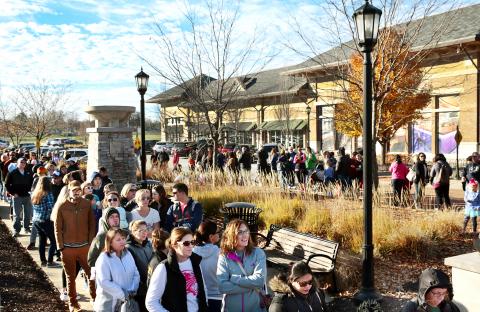US brick-and-mortar retailers did enough things right on Black Friday to consider the event a success, even if the crowds of past years have not returned.
Chains simplified promotions this year and took a keener eye to managing their inventory.
At Wal-Mart Stores Inc, color-coded maps helped shoppers navigate the aisles.

Photo: St Louis Post-Dispatch via AP
Retailers also made headway with their e-commerce sites, aiming to chip away at Amazon.com Inc’s online dominance.
Taken together, the changes might help bolster sales and profit margins — despite a decline in customer traffic at many locations.
“People think retail is a nightmare, but it’s not,” said Tracy Ferschweiler, a Wal-Mart market manager who oversees seven stores in New York and New Jersey.
The weather also provided an assist, with cooler temperatures in much of the US putting shoppers in the mood for coats and sweaters.
However, the day was not without its glitches.
Macy’s Inc, the largest US department store chain, struggled to process credit card transactions. That led to long lines and frustrated customers.
Many retailers are counting on the holidays to help fuel their turnaround plans, and Black Friday is the season’s traditional starting point. Still, the event has lost significance over the years — especially as chains spread out their promotions to attract shoppers earlier in the month.
In the past, Black Friday was famous for crowds bursting through doors and fighting over US$99 DVD players. There is less urgency among shoppers now, but retailers have many advantages this year, including strong consumer confidence and low unemployment.
The day has become more about the experience of shopping, rather than the actual discounts, AlixPartners LLP cohead of retail consulting David Bassuk said.
“People want to start getting into the holiday spirit and enjoy the concept of shopping and the holidays,” he said.
E-commerce continues to outpace brick-and-mortar retail in sales growth, making it crucial for traditional stores to have enticing Web sites and apps.
As of Friday morning, Black Friday online spending was up 18 percent this year, according to Adobe Systems Inc.
Much of that shopping is now occurring on smartphones, with mobile devices accounting for 61 percent of visits.
Meanwhile, physical store traffic was down 4 percent to 6 percent, Cowen & Co analyst Oliver Chen estimated.
Retailers have tried to avoid becoming showrooms for Amazon, meaning customers look at products in their stores and then buy it from the e-commerce giant. To keep shoppers from straying, Walmart and others have pumped billions into their Web operations.
Macy’s has overhauled its rewards program, aiming to keep consumers loyal regardless of whether they are online or off, and for the first time began booking advanced reservations for visits with Santa Claus, a response to time-strapped parents.
Amazon on Friday announced a slew of offerings for Cyber Monday, including discounts on toys, TVs, fashion and Amazon devices such as the Echo program, which can link to Alexa Voice Service.
Customers last year ordered more than 64 million goods on Cyber Monday, 740 items per second, Amazon said in a news release.
Retail experts are generally upbeat about the overall prospects for this year’s holiday shopping performance.
Unemployment stands at just 4.1 percent, US growth stands at about 3 percent and US stock markets are in record range.
Consumers surveyed by the National Retail Federation said they expect an average spend of US$967.13 this season, up 3.4 percent compared with the average in the survey a year earlier.
Additional reporting by AFP

Intel Corp chief executive officer Lip-Bu Tan (陳立武) is expected to meet with Taiwanese suppliers next month in conjunction with the opening of the Computex Taipei trade show, supply chain sources said on Monday. The visit, the first for Tan to Taiwan since assuming his new post last month, would be aimed at enhancing Intel’s ties with suppliers in Taiwan as he attempts to help turn around the struggling US chipmaker, the sources said. Tan is to hold a banquet to celebrate Intel’s 40-year presence in Taiwan before Computex opens on May 20 and invite dozens of Taiwanese suppliers to exchange views

Application-specific integrated circuit designer Faraday Technology Corp (智原) yesterday said that although revenue this quarter would decline 30 percent from last quarter, it retained its full-year forecast of revenue growth of 100 percent. The company attributed the quarterly drop to a slowdown in customers’ production of chips using Faraday’s advanced packaging technology. The company is still confident about its revenue growth this year, given its strong “design-win” — or the projects it won to help customers design their chips, Faraday president Steve Wang (王國雍) told an online earnings conference. “The design-win this year is better than we expected. We believe we will win

Chizuko Kimura has become the first female sushi chef in the world to win a Michelin star, fulfilling a promise she made to her dying husband to continue his legacy. The 54-year-old Japanese chef regained the Michelin star her late husband, Shunei Kimura, won three years ago for their Sushi Shunei restaurant in Paris. For Shunei Kimura, the star was a dream come true. However, the joy was short-lived. He died from cancer just three months later in June 2022. He was 65. The following year, the restaurant in the heart of Montmartre lost its star rating. Chizuko Kimura insisted that the new star is still down

While China’s leaders use their economic and political might to fight US President Donald Trump’s trade war “to the end,” its army of social media soldiers are embarking on a more humorous campaign online. Trump’s tariff blitz has seen Washington and Beijing impose eye-watering duties on imports from the other, fanning a standoff between the economic superpowers that has sparked global recession fears and sent markets into a tailspin. Trump says his policy is a response to years of being “ripped off” by other countries and aims to bring manufacturing to the US, forcing companies to employ US workers. However, China’s online warriors